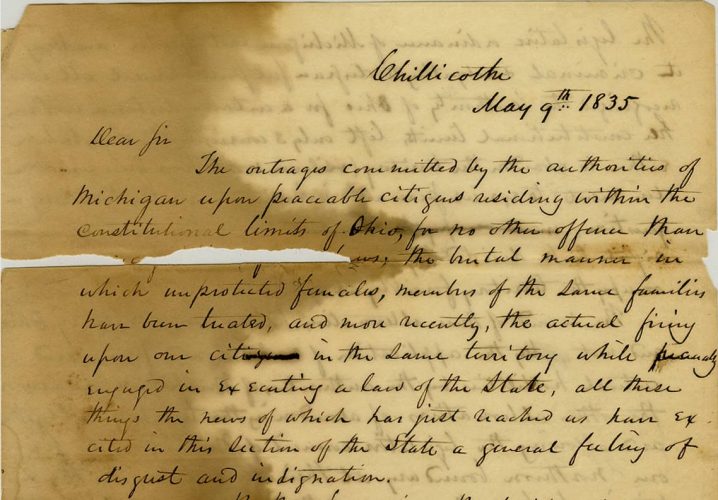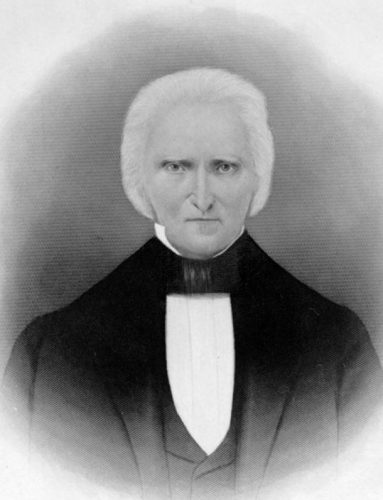“The Outrages Committed by the Authorities of Michigan”: The Toledo War

Ohio’s northern border with Michigan is, peculiarly, a diagonal line, unlike neighboring Indiana’s. The line is a result of Ohio’s eventual “victory” in the so-called “Toledo War,” a prolonged and dramatic boundary dispute between Ohio and Michigan. Ohio ultimately acquired the territory after decades of back-and-forth bickering between the two governments, the stabbing of a Michigan sheriff, and a military stand-off between Ohio’s and Michigan’s militias.
In 1787, the Northwest Ordinance defined the northern boundary of Ohio as “an east west line drawn through the southerly bend or extreme of Lake Michigan.” The problem was that, due to the limitations of map-making at the time, the southern extreme of Lake Michigan was actually further south than originally mapped. The government of the Michigan Territory thus wanted the border reflect the new finding. However, Ohio had already laid claim to the region in its Constitution, which dictated that the northern boundary of the state had to include the Maumee River’s mouth, which laid far north of the line. The result was a 468-square-mile area of land known as the Toledo Strip, which was claimed by both Michigan and Ohio.
As Michigan moved towards statehood, Ohio asked the federal government to declare that the Toledo Strip belonged to Ohio. Only the Senate sided with Ohio. Ohio state representatives helped block legislation making Michigan a state unless Michigan rescinded its claim to the territory. Furious, the Michigan Territory passed the “Pains and Penalties Act” under Governor Stevens T. Mason to punish Ohio officials who tried to exercise jurisdiction over the Toledo Strip. Many Ohio citizens were arrested by Michigan officials in the disputed territory, and the sole casualty of the conflict happened during one of these raids, when Ohio partisan Two Stickney stabbed Michigan Sheriff Joseph Wood with a penknife.

Ohio Governor Robert Lucas addressed the Ohio legislature on June 8th, 1835, urging them to take action in the matter. The legislature duly established the new Lucas County on the 23rd of June, much to the increasing chagrin of Michigan. To further legitimize Ohio’s claim to Toledo, Ohio’s court of common appeals held session in Toledo during the early morning, before Michigan had time to respond.
The situation rapidly approached outright war. Governor Mason ordered the Michigan militia to gather in the disputed area to assert their claim. At the suggestion of Major General James T. Worthington, Governor Lucas ordered Ohio’s militia to mobilize in response to the outrages committed by Michigan. Both sides stood ready on opposite sides of the Maumee River when President Andrew Jackson finally intervened. He removed Mason as the governor of the Michigan Territory and installed John Horner, who finally came to an agreement with Governor Lucas. Ohio would keep the Toledo Strip while Michigan would be granted the Upper Peninsula and statehood. Michiganders were bitter about the result and Ohioans ecstatic. The boundary would be definitively agreed upon for good in 1915, when the governors of the two states met at the border and shook hands.
While the conflict was resolved, the rivalry between the two states did not subside. Ohioans and Michiganders maintained a bitter relationship with one another, and while memory of the conflict subsided, the rivalry lived. It continues to this day most prominently in college football between the Ohio State Buckeyes and the Michigan Wolverines and snide comments made by the respective states’ citizens.
Thank you to Luke LaBuhn for this week’s post! Luke is a junior English major at Kent State University, planning to graduate in May 2020. He plans to pursue a career in librarianship upon graduating and is interning at the State Library of Ohio to learn more about the profession.




Leave a Reply
You must be logged in to post a comment.